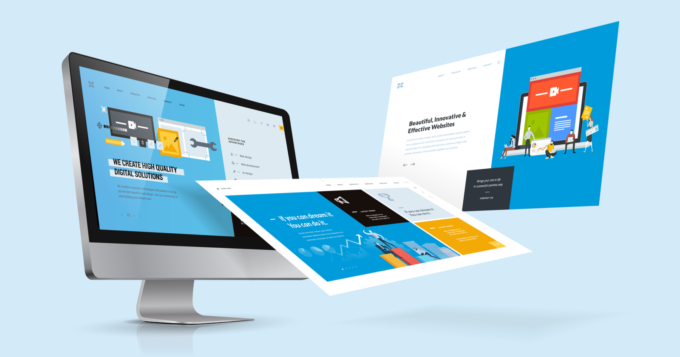
Source: searchenginejournal.com
In the world of business, an online presence is crucial. Creating a powerful website that resonates with visitors often becomes the cornerstone of success. However, building an effective website involves more than just slapping some visuals together.
It takes thoughtful decisions, a strategic layout, and careful consideration of user experience. Many business owners unknowingly stumble into common mistakes that hinder the effectiveness of their website. Let’s explore how to navigate around these pitfalls and produce a true online masterpiece.
Key Points:
- First impressions matter—design should immediately captivate.
- User experience is the cornerstone of every good website.
- Don’t clutter pages with too much information.
- Clear calls to action will drive conversions.
- Optimize for mobile users to increase reach.
First Impressions Matter
The first few seconds of a visit can make or break a user’s interest. People judge quickly. If the layout looks messy or the functionality feels cumbersome, potential clients leave. A professional layout paired with cohesive visuals can instantly elevate credibility. A clean, structured format encourages engagement.
Web design plays an important role. While flashiness might seem tempting, overloading the page with heavy graphics, endless features, and confusing navigation often backfires. Instead, the focus should be on streamlined efficiency, drawing users into the experience without overwhelming them. For those who need guidance, firms like MTM Digital Services provide solutions for small businesses to avoid these pitfalls and create an attractive, lead-generating online presence.
Avoiding Clutter

Source: businessviralindia.com
An overabundance of elements can suffocate the message. Minimalism often leads to higher engagement and better readability. Unnecessary clutter dilutes the core message, confusing users and leading to high bounce rates. The goal should always be clarity. Make it obvious where to click and what to read.
Headlines must stand out. Calls to action need to be visible. The less effort required from visitors, the better. Think of it this way: when every element competes for attention, nothing gets noticed. Strategically placing text, visuals, and calls to action ensures users easily find what they’re looking for, guiding them toward taking meaningful action.
Prioritize User Experience
A site with poor user experience will never succeed, no matter how great the products or services may be. A visitor should feel naturally guided through the site. Confusing menus, dead-end links, or excessive clicking frustrates users and sends them elsewhere. The primary goal should always be to create a smooth experience. Avoid overwhelming navigation menus. Make sure all links function correctly. Check if the buttons clearly direct users where they need to go.
Each element should have a purpose. User interaction becomes smoother when every part of the site works toward a unified goal. Simplify the journey. Once users feel comfortable, they are far more likely to explore further.
Consistency in Visuals and Branding
Visual consistency solidifies trust. Users expect continuity when browsing a business’s site. Fonts, colors, logos, and other brand elements must align to give a sense of unity. Brand recognition grows through repetition. If a site appears fragmented or inconsistent, trust diminishes. Aim for visual consistency across every page.
The balance between text and visuals becomes key here. Each page must carry the same tone, look, and message. Whether large companies or small, establishing trust starts with familiar visuals.
Optimize for Mobile

Source: mmbo.in
More users access the web through mobile devices than ever before. A website that looks stunning on a desktop can easily fail on mobile if not optimized. Every element—buttons, images, text—must adjust seamlessly to smaller screens. Google prioritizes mobile-first indexing, meaning a mobile-friendly layout now directly impacts ranking on search engines.
Without optimization for mobile, businesses miss out on substantial traffic. A responsive layout allows for versatility, making sure the site functions flawlessly across all devices. The reward is significant: increased engagement, better search visibility, and ultimately, more conversions.
Calls to Action Must Stand Out
Every business site aims to turn visitors into customers and calls to action drive this. Whether it’s to contact the business, purchase a product, or sign up for a service, a clear and compelling call to action becomes the bridge to conversions.
Calls to action must stand out. Button placement should be strategic, not hidden. Use action-oriented language that motivates the user to click. Phrases such as “Get Started Now” or “Contact Us Today” create urgency and direct focus. No matter how great a site looks, if users don’t know what step to take next, conversions will remain low.
Keep Load Times Low
If a site loads slowly, users leave. A page must load within seconds, or businesses risk losing valuable traffic. Slow speeds negatively impact both user experience and search engine rankings.
Elements like oversized images, heavy graphics, and unnecessary features can slow load times significantly. Optimize image sizes, reduce the number of plugins, and use tools to monitor site speed regularly. Ensuring fast load times gives visitors no reason to leave.
SEO Still Matters

Source: shorthand.com
Building a beautiful site isn’t enough without traffic. Search Engine Optimization (SEO) remains essential to online visibility. An optimized site ranks higher on search engines, leading to more visitors and potential customers. Effective SEO involves strategic keyword placement, clean code, and relevant, high-quality content.
Meta descriptions, headers, and image tags also play a role in boosting visibility. Regular updates to content and ongoing SEO maintenance will keep a site competitive in the rankings.
Content That Engages
Content shouldn’t be an afterthought. High-quality, relevant content turns visitors into loyal customers. Provide value in every blog post, product description, and service page. Engage users with information that matters. The content must align with the needs of the target audience.
Avoid lengthy blocks of text. Use bullet points, subheadings, and concise paragraphs to maintain interest. Each piece of content should guide the reader naturally, keeping them on the site longer.
Final Thoughts
Creating a successful website involves much more than aesthetics. A combination of strategic layout, optimal performance, and user engagement is necessary for true success. By avoiding common pitfalls, businesses can develop an online presence that not only attracts visitors but turns them into loyal customers.
With the right design and approach, anyone can create an online masterpiece that drives meaningful results.



